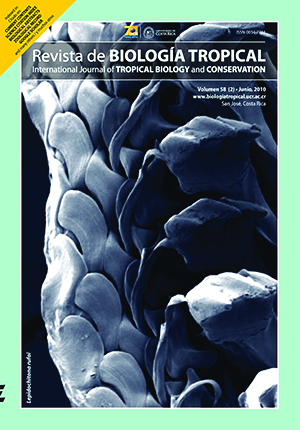Abstract
Biochemical and microbiological properties of soils can provide information related to ecosystems environmental status. With the aim to determine the response of microbial biomass, and enzymatic and microbial activity in hypersaline (IS≥55ups) and saline (IS<55ups) mangrove soils exposed to interstitial salinities (IS) greater than 36ups, these properties were measured in mono-specific forests of Rhizophora mangle at Laguna de la Restinga National Park (Margarita Island, Venezuela). During three seasons (dry, wet and transi-tion), a total of 120 soil samples were collected from ten (5 hypersaline and 5 saline) randomly-selectedsites of 1000m2 each. Four soil samples (400-500g) per plot were randomly collected with a corer at a depth of 10cm using a 1m2 quadrat; each sample consisted in the combination of 8 sub-samples (50-60g ea.). Physical, chemi-cal, enzymatic, biochemical and microbiological properties of soil samples were determined using standard laboratory protocols. The response of microbial biomass and microbial and enzymatic activity was analyzed taking into account spatial and climatic factors and interstitial salinity. Microbial biomass was linked to each locality conditions, and was not sensitive to seasonal or salinity differences. Microbial activity remained func-tionally active during the study period and presented variable responses. Dehydrogenase activity proved to be a good indicator for flooded and anoxic environments, and arginine ammonification resulted to be the more sensitive microbial activity to changes in salinity. Regarding enzyme activities, spatial variability was the most widespread response. We did not find a unique general pattern between enzymatic activities and spatio-temporal variation; and only the enzyme phosphatase was negatively affected by salinity. We conclude that microbial populations of mangrove soils and their activities have functional adaptations to flooded and highly-saline envi-ronments typical of a negative estuary, subjected to drastic changes due to weather and water dynamics. Future studies are needed to determine the relation between the “health” of mangrove forest and microbial populations, and their activities in mangroves soils.
Comments

This work is licensed under a Creative Commons Attribution 4.0 International License.
Copyright (c) 2010 Revista de Biología Tropical






